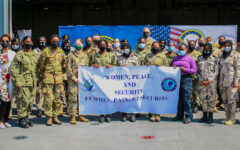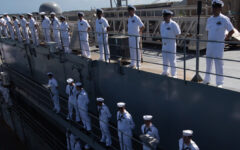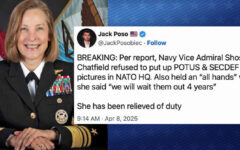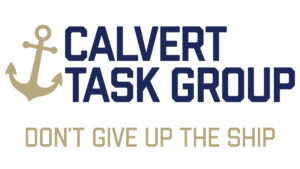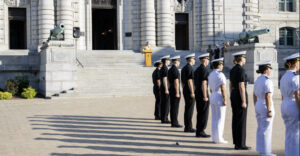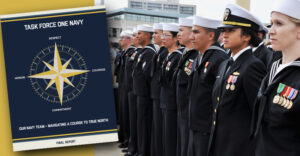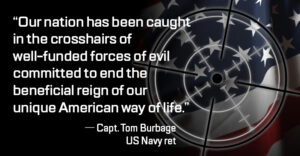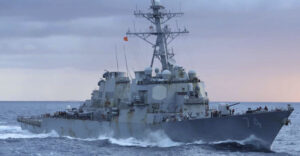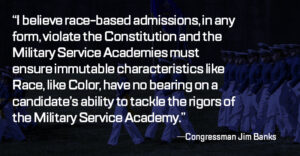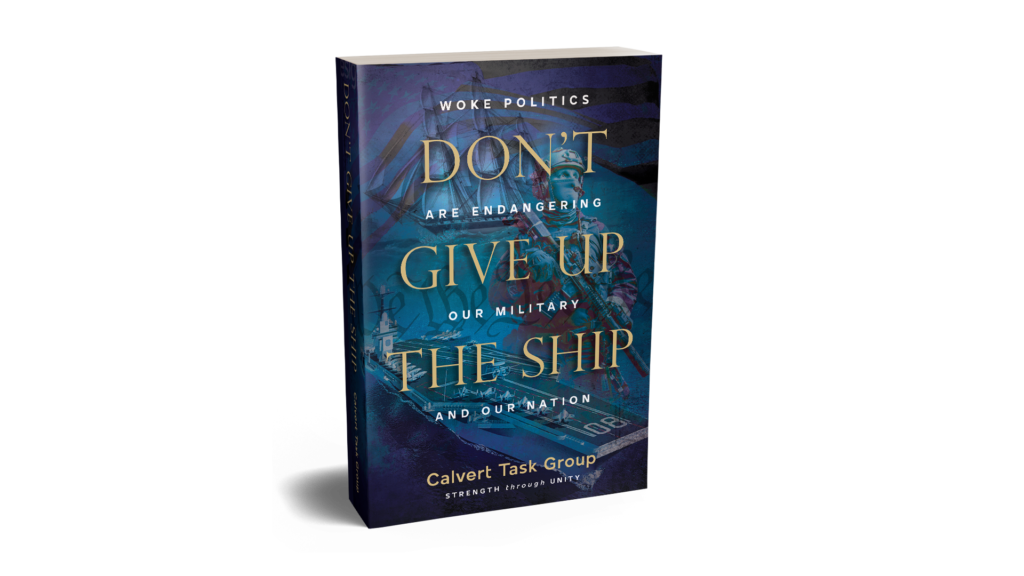Our Navy is “in extremis,” a nautical expression that indicates imminent danger
8 September 2023 2024-05-18 14:02Our Navy is “in extremis,” a nautical expression that indicates imminent danger
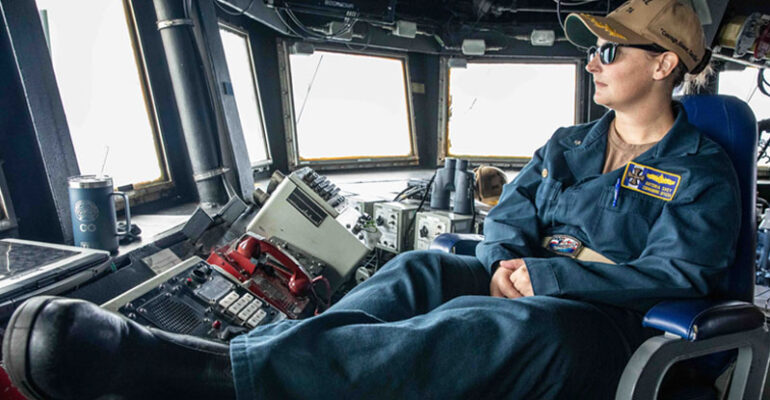
Our Navy is “in extremis,” a nautical expression that indicates imminent danger
By Capt. Brent Ramsey, US Navy, ret
“Now Hear This” is the classic alert in the Navy that something important for all hands is about to be announced. This article is a “now hear this!” for every American.
Our Navy is “in extremis,” a nautical expression that indicates imminent danger. The extremis condition applies to the entire United States Navy and thus to the nation as we are fundamentally a maritime nation.
Virtually everyone agrees that the biggest threat to the US today and our way of life is from China.
As far back as 2000 Congress to its credit recognized that China was going to be a threat and created the US-China Economic and Security Review Commission. The Commission produces an annual comprehensive report typically running 600+ pages on every aspect of the threat posed by China.
In the 2023 report as we came out of the Covid pandemic, we learn things are becoming ever more threatening. The latest report says,
“The CCP gave its leader Xi Jinping unprecedented power over the Party and the country. Xi and the CCP relied ever more heavily on nationalist appeals, as was evident in its escalating rhetoric and menacing military actions toward Taiwan.
Faced with a series of crises and unexpected developments, China’s Communist Party regime reacted, not by reexamining its assumptions and modifying its approach, but rather by doubling down on existing policies.
In the near term these choices have increased the challenge China poses to the security, prosperity, and shared values of the United States and its democratic allies and partners.”
A significant part of countering external threats from China falls to the Navy as the most serious threats manifest themselves in maritime scenarios especially in seas adjacent to China. Recognizing this threat from the PRC is why the largest combatant command is INDOPACOM.
Fully 60% of our forward deployed naval combatants are in the Pacific keeping watch on China.[i]
- Fact 1: The world is 70% ocean.
- Fact 2: 90% of the world’s commerce goes by sea.
- Fact 3: One third of the entire world’s commerce transits the South China Sea which is contiguous to mainland China.
- Fact 4: Any conflict with the PRC over Taiwan or any other pacific ally will totally disrupt the world’s economy including that of the US. If you value your current lifestyle and comforts, you need to recognize this threat. War with China has the potential to change literally everything.
Just how well we are meeting the threat and effectively dealing with it? The media, prominent politicians of both parties, and citizens alike have raised the alarm about our Navy.
To assess the Navy, we should look at three main categories, capability, readiness, and leadership.
Capability
In 2016 the Navy said its requirement was for 355 combatant ships. In 2018 the National Defense Authorization Act (NDAA) mandated a Navy of 355 combatants finally recognizing the increasing threat. Five years later in 2023, the Navy as of April 2023 had 296 ships and will actually decrease to 293 by the end of 2024 according to the Congressional Research Service (CRS)[ii].
No plan put forth by the Navy or Congress will get us to the mandated number of ships before the 2050’s at the earliest. The Navy and the Marine Corps cannot even agree on the number of Amphibious ships we should have.
A Congressionally mandated shipbuilding requirement study, the “National Commission on the Future of the Navy” which was created in the 2023 NDAA has not even started to work to pin down an upgraded requirement for ships. That Commission is expected to confirm a requirement substantially larger than the number mandated by the NDAA 5 years ago.
Heritage Foundation in its 2023 Index of Military Readiness Strength Report[iii] concluded that the Navy needs at least 400 manned combatants and assessed the Navy’s capability as “weak.”
Even if the Navy and Congress could agree on the number of ships that are needed to defend the nation against the PRC and others and Congress actually authorized the money to build those ships, the US lacks the industrial capability to build the ships that we need.[iv]
Recently departed CNO ADM Gilday said on numerous occasions “the biggest impediment to building the ships we need is lack of industrial capacity.[v]
Contrast our ~60 ships in the INDOPACOM area of responsibility with the CCP’s 2025 projected 400 combatants according to the CRS[vi], 150 armed Coast Guard ships[vii], and hundreds more of its Maritime Militia.
The unbalance in the Pacific is dangerous to the US and our allies and is getting more lopsided by the day.
Readiness
That same industrial maintenance capability is likewise woefully under-resourced as is evidenced by the horrendous record in recent years of maintenance delayed for years and ships taking much longer to repair and at a higher cost than estimates indicated.
The GAO in January 2023 reports, that “Sustainment Challenges Have Worsened across the Ship Classes Reviewed.”
“GAO reviewed key sustainment metrics for 10 ship classes and found that from fiscal years 2011 through 2021, these classes faced persistent and worsening sustainment challenges.”[viii]
GAO reports “From 2017 to 2020, the backlog of restoration and modernization projects at the Navy shipyards has grown by over $1.6 billion, an increase of 31 percent.”
And “In 2018, the Navy estimated that it would need to invest about $4 billion in its dry docks to obtain the capacity to perform the 67 availabilities it cannot currently support. This estimate included 14 dry dock projects planned over [a] 20-year span. However,…the Navy’s first three dry dock projects have grown in cost from an estimated $970 million in 2018 to over $5.1 billion in 2022, an increase of more than 400 percent.”
Heritage found the Navy to be either weak or very weak in readiness.[ix]
At a time of increased threat, the Navy has clearly lost ground on keeping ships ready for sea.
Unready ships and deferred or cancelled maintenance puts an added burden on the ship’s crews.
Leadership
Navy Leadership has been questioned in very public ways in recent years by an astounding series incidents, accidents, and sideshows. These leadership lapses have called into question the quality of Navy leadership.
—The collisions of the USS McCain and USS Fitzgerald led to the unnecessary loss of precious lives. These collisions brought needed scrutiny to the “fighting culture” of Navy’s surface warfare community. The attention was so great that Congress members got involved and appointed their own experts to examine the issue in a scathing special report on the Surface Navy[x].
—The USS Bonhomme Richard, a $3 BILLION capital ship, burned to a smoking hulk tied up to the pier. The Navy was incapable of fighting the fire and the ship was a total loss and was stricken from the records. The JAG manual investigation that followed implicated poor leadership as the culprit with dozens of senior officers found at fault.[xi] That ship was lost to the Navy forever along with its capability.[xii]
—During Covid there was the incident of the over-reaction of the skipper of the USS Roosevelt to the pandemic that ultimately evolved into the Secretary of the Navy resigning in embarrassment over his insulting public remarks made to the crew in reference their former CO.[xiii]
—A recent survey of Surface Navy officers revealed that most junior surface warfare officers do not aspire to command in their community.[xiv] How is that even possible that we are recruiting and retaining officers who do not want to be in command? This is institutional weakness personified.
—Two entire ship classes, the Littoral Combat Ship (LCS) and Zumwalt class, are utter failures and another class, the Ford class carrier is still beset with major problems in operational effectiveness more than 6 years after commissioning.
The LCS proved to be so bad and ineffective that the Navy is retiring the entire class decades before its expected lifespan, a spectacular waste of billions.
The Zumwalt class destroyers are likewise an embarrassment with almost zero capability after the Navy spent more billions. Instead of being a productive part of the fleet with a proven capability for warfighting, the ship class has been reduced to being multi-billion-dollar test ships.
Imagine the embarrassment of putting to sea with no working weapons systems on board, a naval gun mount with no shells to fire. That is the Zumwalt class. The Ford has finally deployed after years of delay, but the Navy admits that it still has not worked out the bugs in 5 major components of the ship class, most of which impact the ability to generate a high number of aircraft sorties, the preeminent metric for a carrier.
And, cost wise, the Ford class carriers are costing billions more than was estimated at $13 BILLION per ship. The CRS has reported in detail about the continuing problems with the Ford class in its regular reports.[xv]
There appears to be no accountability for these spectacular failures, the wasting of billions, and the lack of adequate numbers of ships for the fleet.
—In the past two years, the Navy has missed its recruiting goals. Even after lowering admission standards the trend in recruiting has not improved. Fewer and fewer American youth even want to serve in the Navy and the Navy’s message has not resonated with that essential group for the sustainment of the force.
—The Navy continues to have a high suicide rate despite wringing its collective hands over the problem for years.
Covid led to the deaths of 17 sailors total through 6 December 2022 when the last DOD report was issued.[xvi] During 2020-2022 the Navy had 194 suicides.[xvii]
More than 10 times as many sailors took their own lives per year than were lost to Covid through the entire pandemic.
Yet the Navy devoted a massive effort to vaccinate the entire Navy which was always at extremely low risk from covid.
Was there any focused attention to the suicide problem that took dozens of lives each year? There is no evidence to suggest it was treated as any sort of priority.
In 2023, the Navy is now trying to recruit enough Chaplains so that every destroyer can have a permanent party chaplain onboard. In this author’s experience, having a squadron chaplain serving 8 destroyers was effective.
Has American culture eroded so much and gotten so fragile that to prevent mass suicides, a Chaplain is required on every ship?
Is our recruiting screening deficient such that high numbers of mentally susceptible to suicide personnel are being accessed into the Navy?
In no case has Navy leadership risen to the occasion and addressed or solved these seemingly intractable problems. Is that because they are too hard? Or is it the lack of the kind of inspired leadership that was typical of the Navy in the past from famous Navy leaders of yore like Jones, Barry, Farragut, King, Nimitz, Halsey, Burke, Perry, and Calvert?
Lastly, and the elephant in the room regarding leadership, is the Navy’s inexplicable devotion to and zeal in promoting the woke concepts of the political left.
Things like Diversity, Equity, and Inclusion, month long Pride celebrations for the tiny percent of the Navy that are gay, promoting drag queen shows on ships (the CO who authorized this outrageous conduct by active-duty sailors was selected for flag), accommodating so called transgendered personnel who want to change their gender, promoting what pronouns must be used are now commonplace throughout the Navy.
How do these emphases create the warriors? How do these programs make our ships more lethal?
Focus on “social justice” ideology adds not one whit to our effectiveness and lethality as a naval force. There is not a scintilla of evidence that DEI improves the readiness of the Navy.
Not explained is how these social fads or influences of our secular society enhance lethality, improve morale or readiness, or make for a more effective Navy to defend our nation.
At best they are a harmless distraction and resources drain instead of a laser focus on more important things.
At worst, they are an erosion of the core values of merit, courage, honor, and commitment that the Navy emphasized when I served for decades. Those traditional values were what it took to defeat the Soviet Union. And, I am proud of what we accomplished bolstered by those values.
Surveying the state of the Navy is a sorrowful exercise for this life-long Navy man. I grew up in the Navy as the son of a Master Chief and my entire adult life has been in service to the Navy that I love.
Will we have the ships we need to fight our enemies? Will the ships we have be ready for sea? Will the ships be manned by those selected for their high merit and warrior characteristics?
Or, will our new woke Navy be up to the task even if we overcome the deficiencies in capabilities, readiness and other leadership failures described above?
Citizens must ask themselves and others these important questions. And, if you do not like the answers you are getting, contact your elected representatives and sound the alarm.
Your lives and way of life depend on it.
CAPT Brent Ramsey, (USN, ret.) is a writer on Defense matters. He has been featured in Washington Examiner, Real Clear Defense, Armed Forces Press, CD Media, American Thinker, and Patriot Post. He is a leader with the Calvert Group, a Board of Advisors member for the Center for Military Readiness and STARRS and is a contributor to Armed Forces Press.
Notes:
[i] USNI News Fleet and Marine Tracker, August 28, 2023, USNI online
[ii] Navy Force Structure and Shipbuilding Plans: Background and Issues for Congress, April, 19, 2023, Congressional Research Service
[iii] https://www.heritage.org/military-strength/assessment-us-military-power/us-navy, accessed September 3, 2023
[iv] ANALYSIS: Shipyard Capacity, China’s Naval Buildup Worries U.S. Military Leaders, January 26, 2023, National Defense Magazine
[v] CNO Admiral Gilday stated in August of 2022, that “the biggest barrier to adding more ships to the Navy is the industrial base capacity.” Congressman Grothman: U.S. Naval Shipbuilding Capacity Must Compete With China & Russia – United States House Committee on Oversight and Accountability, Congressional Hearing, 11 May 2023
[vi] China Naval Modernization: Implications for United States Navy Capabilities, May 15, 2023, Congressional Research Service
[vii] China adds 22 ships to world’s largest coast guard fleet, Japanese news agency says, February 2, 2023, Stars and Stripes
[viii] Weapons System Sustainment: Navy Ship Usage Has Decreased as Challenges and Costs Have Increased, January 2023, GAO-23-106440
[ix] https://www.heritage.org/military-strength/assessment-us-military-power/us-navy, accessed September 3, 2023
[x] A Report on the Fighting Culture of the United States Navy Surface Fleet, Commissioned by Senator Tom Cotton, Congressman Jim Banks, Dan Crenshaw and Mike Gallagher, December 2021
[xi] The Navy finds major failures starting with top officers in a devastating ship fire, October 19, 2021, National Public Radio online
[xii] Long Chain of Failures Left Sailors Unprepared to Fight USS Bonhomme Richard Fire, Investigation Finds, October 19, 2021, USNI News
[xiii] Modly Resigns as Acting SecNav Amid Backlash Over Carrier Captain’s Firing, April 7, 2020, www.Military.com.
[xiv] Surface Warfare Tackles Persistent Problems as More Than Half of JO’s Say They Don’t Want Command, June 19, 2023, USNI online
[xv] Navy Ford Class Aircraft Carrier Program, August 16, 2023, Congressional Research Service
[xvi] Nearly 100 Deaths, Half a Million Cases: The Toll from 3 Years of the Coronavirus Pandemic on the Military, March 28, 2023, Military.com
[xvii] It ‘keeps us awake’: Navy leaders say sailor suicides are huge concern, January 11, 2023, Navytimes.com
First published in Real Clear Defense
NAVY PHOTO: GULF OF OMAN (Sept. 2, 2023) Cmdr. Antonia Shey, commanding officer of the guided missile destroyer USS McFaul (DDG 74), oversees sea and anchor operations in the Gulf of Oman, Sept. 2, 2023. McFaul is deployed to the U.S. 5th Fleet area of operations to help ensure maritime security and stability in the Middle East region. (U.S. Navy photo by Mass Communication Specialist 2nd Class Juel Foster)


